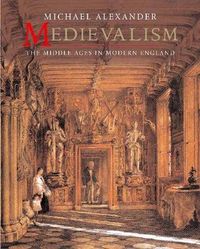
Medievalism
The style of the medieval period inhabits the bloodstream of western culture, and returned to dominate post-Enlightenment England. This one-volume history of the Medieval Revival as a whole is the first coherent account of its social, political, religious, architectural and artistic aspects, especially as these are expressed and reflected in literature. Its focus is on the period 1760 to 1971, with an Epilogue on the reverberations of medievalism in the present day. The rebuilding of the Palace of Westminster, after its destruction by fire in 1834, re-established Gothic as a national style. But medieval imitation manifests itself wherever one cares to look: in literature (Horace Walpole, Scott, Tennyson, Ruskin); in architecture (on campuses from Glasgow to Sydney to Yale, follies from Strawberry Hill to San Simeon, in churches, banks and railway stations); in the decorative arts (Pugin, William Morris, Eric Gill); religion (the Oxford Movement); politics (Guild Socialism and the trade union movement) and Hollywood (Braveheart, Robin Hood, and The Name of the Rose). In this skilled dissection of the components of this pervasive cultural movement, Michael Alexander rejects the idea that medievalism was confined to the Victorian period, and overturns the suspicion that it is by its nature escapist.
Utgiven: 2007
ISBN: 9780300110616
Förlag: Yale University Press
Format: Inbunden
Språk: Engelska
Sidor: 352 st
The style of the medieval period inhabits the bloodstream of western culture, and returned to dominate post-Enlightenment England. This one-volume history of the Medieval Revival as a whole is the first coherent account of its social, political, religious, architectural and artistic aspects, especially as these are expressed and reflected in literature. Its focus is on the period 1760 to 1971, with an Epilogue on the reverberations of medievalism in the present day. The rebuilding of the Palace of Westminster, after its destruction by fire in 1834, re-established Gothic as a national style. But medieval imitation manifests itself wherever one cares to look: in literature (Horace Walpole, Scott, Tennyson, Ruskin); in architecture (on campuses from Glasgow to Sydney to Yale, follies from Strawberry Hill to San Simeon, in churches, banks and railway stations); in the decorative arts (Pugin, William Morris, Eric Gill); religion (the Oxford Movement); politics (Guild Socialism and the trade union movement) and Hollywood (Braveheart, Robin Hood, and The Name of the Rose). In this skilled dissection of the components of this pervasive cultural movement, Michael Alexander rejects the idea that medievalism was confined to the Victorian period, and overturns the suspicion that it is by its nature escapist.
Begagnad bok (0 st)
Varje vecka tillkommer tusentals nya säljare. Bevaka boken så får du meddelande när den finns tillgänglig igen.



